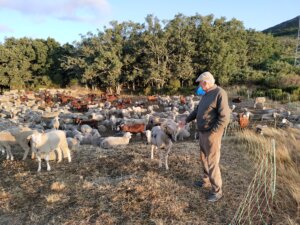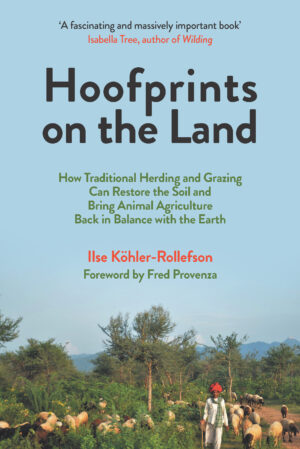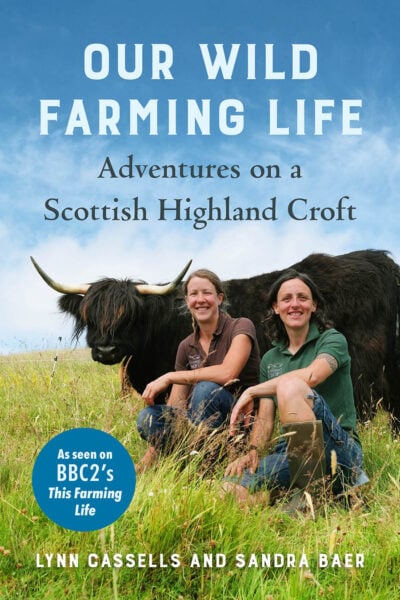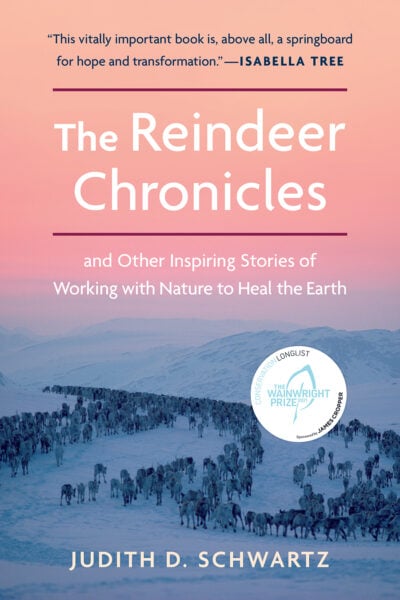Human and Animal Alliances: A Mutual Partnership
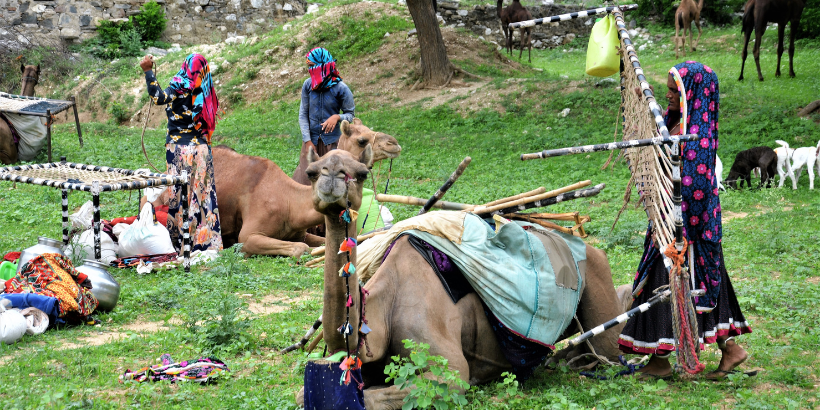
When humans and animals interact, both parties benefit in some way from the exchange. While individuals may receive resources and feel a sense of joy & purpose from interacting with wildlife, the animals receive care & companionship from the humans. These alliances, when properly nurtured, can work wonders for our world.
In the excerpt below from Hoofprints on the Land, Ilse Köhler-Rollefson highlights some notable human & animal alliances and offers insight on how we can establish these strong and mutually-beneficial relationships.
The following is an excerpt from Hoofprints on the Land by Ilse Köhler-Rollefson. It has been adapted for the web.
The Passion of Pastoralists
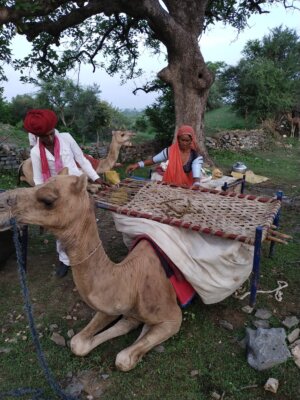 Pastoralists care for, respect and even venerate their animals – as behoves a partner without whom there would be no life. This love and respect are not sentimental, nor reflective of the kind of concern that the animal-welfare community espouses, but is created by mutual dependence. People and animals are in it together: without the other neither can survive.
Pastoralists care for, respect and even venerate their animals – as behoves a partner without whom there would be no life. This love and respect are not sentimental, nor reflective of the kind of concern that the animal-welfare community espouses, but is created by mutual dependence. People and animals are in it together: without the other neither can survive.
Here is how a pastoralist woman describes how she feels about the sweaty and back-breaking work of collecting fodder for her calves, a task that requires walking long distances over rough terrain, cutting a bundle of different plants and then carrying home the heavy load:
“The reason why I feel happy is: I don’t beg. I just herd my animals and when they come back in the evening I just milk. If my family is hungry, I can slaughter for them. During the rainy season when there is good milk, I process to get butter from them. That is why I don’t even feel the hardness of these jobs.” 18
The woman quoted belongs to the Borana, a cattle-herding group residing in Northern Kenya and Southern Ethiopia that is famous for a unique community governance system and for its very complex institutions around managing animals, grazing and water resources in an equitable way. Traditionally, the labour around livestock was shared between men and women, but with many men seeking outside work, a whole range of responsibilities now often falls on women.
Alliances Between Animals & Humans
Such alliances with livestock underlie human existences in most of the world and, to give you a sense of the enormous spread of partnerships across continents and cultures, here are some of the most intriguing examples:
Reindeer. In the circumpolar region, reindeer are the source of life for a total of 20 different ethnic groups, including the Sami, Evenki, Eveny and Chukchi. Ferreting out forage in the tundra and taiga, including the leaves of birch and willow trees, lichens and reindeer moss, even under a deep layer of snow, reindeer provide their herd- ers with food (milk and meat), clothing and shoes (made from their fur), transportation (pulling sledges or as riding animals), housing (tents made from skins) in temperatures that can be as low as -71°C (-96°F).
These antlered creatures do not just serve up material benefits, but also nourish the souls of their keepers and protect them from evil. British anthropologist Piers Vitebsky, who spent decades living among the Eveny in Siberia and Eastern Russia, reported that, in earlier days, the Eveny undertook annual soul-voyages to the Sun on the back of their reindeer, from which they returned tired but happy and relaxed. He hypothesised that it was the reindeer that had domesticated people, instead of vice ver- sa.19 Herded reindeer have a much longer lifespan than their wild relatives, on average living to the age of 18 years instead of ten.
Yaks. I encountered and rode these shaggy creatures during a short trek in the Indian Himalayas. I was surprised how comfortable they are to sit on and how easy to handle. Unfortunately, they only do well at higher altitudes of 3,000–5,000m (10,000–16,000ft) above sea level. In the high mountains of Asia, the Pamir and the Himalaya-Hindukush range and on the Tibetan Plateau, they are the foundation of the livelihoods of around thirty ethnic groups for whom they provide transportation, clothing, furniture and housing, fuel, and food.20 The significance of yaks goes beyond the material: their Buddhist keepers regard them as safe-guarding gods and assign cultural and religious significance to each of the yak’s body parts. Yak heads are placed on the walls of houses and sometimes a yak carcass is hung up to ward off evil spirits. Yak butter sculptures are burned as offerings to the gods and can be found in most of the monasteries of the Tibetan area.
Water buffaloes. I have encountered buffaloes almost everywhere in India in a range of environments, from the alpine meadows of the Himalayas to the arid expanse of the Kutch Desert, the lagoons of the Bay of Bengal to the jungles of the Deccan Plateau. They are a lifeline to both Hindu and Muslim herding communities. The most treasured product of these sluggish- looking animals is milk with a very high fat content. I have had the pleasure of meeting the Van Gujjars, a community of Muslim buffalo breeders who seasonally migrate from the foothills to the alpine pastures of the Himalayas to ensure the well-being of their herds. They treat their animals, which also include ponies to carry their belongings, as family members. American writer Michael Benanav documented how the young men of a Van Guj- jar family carried a young buffalo with a broken leg over long distances on their shoulders so they would not have to abandon it.21 Indian veterinarian Balaram Sahu described how the buffa- loes of the Chilika Lake in India swim out to graze on shifting islands where their presence attracts crowds of migratory birds who feed on the insects that multiply in the dung and the puddles left by hoofprints.
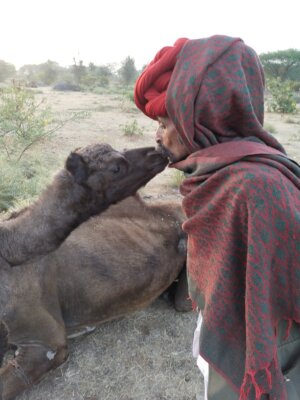 One-humped camels. My favourite animal, the one-humped camel, is at the centre of pastoralist societies in the harsh deserts and steppes that stretch out between Mauretania on the west coast of Africa to the Thar Desert in India. The largest concentration of one-humped camels is in the Horn of Africa where camel milk is the dietary staple of the Somali community. A common practice among these diverse groups was never to sell camel milk, and only give it away for free to people in need. The Afar from the drylands of Ethiopia put it like this: ‘If a son dies, he is buried, but life goes on and you may have another son. But if a camel dies, everything comes to a halt and without movement there is no life and the household breaks down.’22
One-humped camels. My favourite animal, the one-humped camel, is at the centre of pastoralist societies in the harsh deserts and steppes that stretch out between Mauretania on the west coast of Africa to the Thar Desert in India. The largest concentration of one-humped camels is in the Horn of Africa where camel milk is the dietary staple of the Somali community. A common practice among these diverse groups was never to sell camel milk, and only give it away for free to people in need. The Afar from the drylands of Ethiopia put it like this: ‘If a son dies, he is buried, but life goes on and you may have another son. But if a camel dies, everything comes to a halt and without movement there is no life and the household breaks down.’22
Two-humped camels. In the Gobi and Taklamakan Deserts in Mongolia and China, the two-humped Bactrian camel thrives on salty, dry, thorny and bitter plants. Turkic and Mongol nomads process camel milk into a range of dairy products, including cheeses and vodka home-distilled from fermented milk. The long, fine hair of the Bactrian camel is a much sought-after raw material for making luxury garments.23
Cattle. Practised in many parts of the world, pastoralism is – or was – especially prominent in India and Africa and has also given rise to many cattle cultures. Among them are the Fulani, a group of cattle herders who inhabit the Sahelian belt that stretches across Africa from west to east. One of the Fulani subgroups, the WoDaaBe of Niger, have bred the Bororo breed of cattle which amazed colonial veterinarians with its ability to thrive during a nine-month dry period and on pastures that seemed unproductive. The breed has survived major drought periods and is highly desired for export, according to Saverio Krätli, an Italian-born social scientist who has studied the relationship between the WoDaaBe and the Bororo cattle in depth.24 Cattle pastoralism is also practised in Spain where hun- dreds of cows trek 300km (186 miles) from winter pastures in the south to summer grazing in the mountainous interior in a journey that takes 15 days. In Northern Greece, especially in Thessaly, cattle traditionally stayed in the lowlands during the winter and moved into the highlands in the summer. These systems were focused on meat production, required no capital and absorbed family labour.25
Sheep. Found all over the world, sheep are kept by Muslims, Hindus, Buddhists and Christians over a vast range of ecological zones that range from extreme drylands to places with exceptionally high rainfall. The Bedouins of the Syrian Desert bred the Awassi sheep, which stores fat in its tail to see it through prolonged droughts. At the other end of the rainfall spectrum, the Kuruba pastoralists of the Western Ghats in India have developed the black Deccani sheep, a breed that is impervious to the extreme wetness resulting from annual rainfall amounts of 900cm (350in) pouring down during the few months of the monsoon. The wool of this animal is woven into ritual blankets that are necessary for the life cycle rituals of the Kuruba. Community members take care of a huge flock of sacred sheep. The same group of shepherds worships wolves because they think they are essential for keeping their flocks healthy by culling weak and sick sheep.26 Seasonal sheep movements are widespread in almost all countries of Europe, notably in Spain and in the Carpathians.
Horses. An animal of the Eurasian steppes where they were first domesticated, horses have gradually been adapted to totally dif- ferent environments, ranging from the icy climes of Siberia and Iceland to the torrid heat of the Arabian Desert. Horse nomadism is a key feature of Central Asian culture, enabling the rise of the Mongol Empire. In Mongolia, horses are not just a source of trans- portation but also of food. Fermented mare’s milk is popular among many Central Asian societies. In Europe, there are several instances of horses kept in free-ranging systems in which they are rounded up once or twice annually, such as in the Camargue in France and in Iceland. The Mérens horses of Southern France were bred in transhumant systems, moving to summer pastures in the Pyrenees during spring and returning to the valleys in autumn. The practice is being revived and attracts tourists who accompany the trek.
Donkeys. Originating in Northern Africa, donkeys first came to prominence in ancient Egypt. While few herding societies cen- tre on them, they are often used as docile adjuncts for carrying household belongings during migration, including by the Raika in Rajasthan and the Turkana in Kenya. In the Sicilian town of Troina, the revival of the ancient practice of moving donkeys from the plain to uplands during the summer months enabled citizens to wrest control over forestland from the Mafia and to provide employment for young people, while also conserving the Ragusano donkey breed and the Sanfratellano horse.27
Llamas and alpacas. In the South American Andes, llamas and alpacas were domesticated by the Incas, diminished by the Spanish colonists, and are now kept by both Aymara- and Que- chua-speaking pastoralists for whom the relationship with these animals is part of their identity. Alpacas were mostly kept for their wool and historically yarn was an important trade item, while llamas were used for transportation. The two closely related spe- cies were important for rituals while their meat was also valued. Alpaca herders in the South American Andes say, ‘In the same way as we nurture alpacas, they nurture us’ and ‘the day alpacas disappear, the world will disappear.’28
Goats. Everybody loves curious goats, and they are easily the most adaptable and easy to manage animal. They form the basis of the culture and livelihoods of a diverse range of pastoralists on all con- tinents. I have visited both the Bakkarwal pastoralists of Kashmir in India29 and the Crianceros of the Argentinian Andes, both of whom cover large distances between specific summer and winter grazing sites, a practice referred to as ‘transhumance’ that is also followed in many European countries, including Greece, Spain, Switzerland and Austria, usually in combination with sheep. But goats are also making inroads into conservation grazing to control weeds or prevent forest fires, and they are widely used for this pur- pose in California where they were recently reported to have saved the Presidential Library of —Ronald Reagan from burning down.30
Notes
18. Marie-Luise Hertkorn, Hassan Roba and Brigitte Kaufmann, ‘Caring for Livestock: Borana Women’s Perceptions of Their Changing Role in Livestock Management in Southern Ethiopia’, Nomadic Peoples 19, no. 1 (2015): 30–52.
19. Piers Vitebsky, Reindeer People: Living with Animals and Spirits in Siberia (London: HarperCollins, 2005): 10–11.
20. Srijana Joshi et al., ‘Ethnic and Cultural Diversity amongst Yak Herding Communities in the Asian Highlands’, Sustainability 12 (2020): 957, https://doi.org/10.3390/su12030957.
21. Michael Benanav, Himalaya Bound: One Family’s Quest to Save Their Ani- mals – And an Ancient Way of Life (New York: Pegasus Books, 2018); see photo on VoA, 22 June 2018; images from Michael Benanav’s journey with the Van Gujjars of Northern India, https://www.voanews.com /a/himalaya-bound/4450698.html.
22. Tegegne Teka. ‘Camel and the Household Economy of the Afar’. Nomadic Peoples 29 (1991): 31–41. https://www.jstor.org/stable /43123336.
23. Pamela Burger, E. Ciani and B. Faye, ‘Old World Camels in a Modern World – A Balancing Act Between Conservation and Genetic Improve- ment’, Animal Genetics 50, no. 6 (2019): 598–612, https://doi.org /10.1111/age.12858.
24. Saverio Krätli, ‘Cattle Breeding, Complexity and Mobility in a Structur- ally Unpredictable Environment: The WoDaaBe Herders of Niger’,Nomadic Peoples 12, no. 1 (2008): 11–41.
25. Athanasios Ragko et al., ‘Current Trends in the Transhumant Cattle Sector in Greece’, Scientific Papers: Animal Science and Biotechnologies 46, no. 1 (2013): 422–426.
26. Ilse Köhler-Rollefson, ‘The Shepherds that Worship Wolves’, Live- stock Futures, 23 February 2015, http://www.ilse-koehler-rollefson .com/?p=898.
27. Alessandro Puglia, ‘Gli Asinelli Che Hanno Sconfitto la Mafia’ [The Donkeys Who Defeated the Mafia], Vita, 21 February 2021, http:// www.vita.it/it/story/2021/02/21/gli-asinelli-che-hanno-sconfitto -la-mafia/388/.
28. Grimaldo Vásquez, ‘Culture and Biodiversity in the Andes’, Forest, Trees and People Newsletter 34 (1997): 39–45.
29. Anita Sharma, The Bakkarwals of Jammu and Kashmir: Navigating through Nomadism (New-Delhi: Niyogi Books, 2009).
30. Oliver Milman, ‘Five Hundred Goats Save the Ronald Reagan Library from Wildfires’, The Guardian, 31 October 2019, https://www.theguardian .com/us-news/2019/oct/31/goats-save-ronald-reagan-library-wildfire.
Recommended Reads
Bringing Back Balance: The Power of Traditional Herding & Grazing
Recent Articles
Everyone loves a refreshing, fermented, nutritious drink…even your garden! Take your fermentation skills out of the kitchen and into the garden by brewing fermented plant juice. The following is an excerpt from The Regenerative Grower’s Guide to Garden Amendments by Nigel Palmer. It has been adapted for the web. How to Make Fermented Plant Juice Fermented…
Read MorePeregrine falcons, while known as predators, are essential to our environment. These stunning birds have a rich history, an interesting present, and an uncertain future. The following is an excerpt from Feather Trails by Sophie A. H. Osborn. It has been adapted for the web. Who Are Peregrine Falcons? Though relatively uncommon wherever it occurs,…
Read MoreWant to see your crops thrive this upcoming growing season? The key is in soil fertility and health. Spend time maintaining your soil’s health to guarantee bigger and better crops come harvest time! The following is an excerpt from No-Till Intensive Vegetable Culture by Bryan O’Hara. It has been adapted for the web. What Is Soil Fertility?…
Read MoreMany know the effects of catnip on our feline friends, but few realize that catnip has medicinal effects for humans. From stomach aches to reducing fevers, catnip is a versatile herb with many benefits. The next time you grow this plant for your cat you may end up taking a few cuttings for yourself! The…
Read MoreIt’s time to take control of your seeds and become a plant breeder! Saving your seed allows you to grow and best traditional & regional varieties, and develop more of your own. The following excerpt is from Breed Your Own Vegetable Varieties by Carol Deppe. It has been adapted for the web. Becoming A Plant…
Read More

